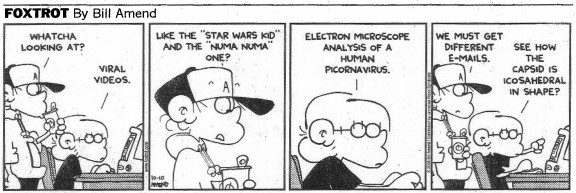Virology – Biology 3310/4310
Spring 2019
The complete 2018 virology course materials are available at virology.ws/virology-course-2018


This Columbia University virology course is offered each year in the spring semester.
Prerequisite: Two semesters of a rigorous, molecularly-oriented Introductory Biology course (such as C2005), or the Instructor’s permission (vrr1@columbia.edu).
Course Name: Virology
Sessions: M, W 4:10 – 5:25 PM
Start date: Wednesday, January 23, 2019
Points: 3
Location: Pupin 301
Course #: Biology UN3310.001 or GR4310.001
Instructor: Prof. V. Racaniello
Description
The basic thesis of the course is that all viruses adopt a common strategy. The strategy is simple:
1. Viral genomes are contained in metastable particles.
2. Genomes encode gene products that promote an infectious cycle (mechanisms for genomes to enter cells, replicate, and exit in particles).
3. Infection patterns range from benign to lethal; infections can overcome or co-exist with host defenses.
Despite the apparent simplicity, the tactics evolved by particular virus families to survive and prosper are remarkable. This rich set of solutions to common problems in host/parasite interactions provides significant insight and powerful research tools. Virology has enabled a more detailed understanding of the structure and function of molecules, cells and organisms and has provided fundamental understanding of disease and virus evolution.
The course will emphasize the common reactions that must be completed by all viruses for successful reproduction within a host cell and survival and spread within a host population. The molecular basis of alternative reproductive cycles, the interactions of viruses with host organisms, and how these lead to disease are presented with examples drawn from a set of representative animal and human viruses, although selected bacterial viruses will be discussed.
Textbook
The recommended textbook is Principles of Virology. Vol I: Molecular Biology, Vol. II: Pathogenesis and Control (S.J. Flint et al., Third Edition, ASM Press 2015).
Other course resources
1. Students should read Prof. Racaniello’s virology blog for information relevant to the course.
2. Students should listen to the weekly podcast “This Week in Virology”, produced by Prof. Racaniello, for additional material about viruses relevant to the course. You can subscribe to TWiV at iTunes.
3. Lecture slides (pdf) will be posted at this website before each class.
4. Videocasts of all lectures (slides plus audio) will be posted at this website.

Hello Dr. Racaniello,
Thank you for your wonderful lectures. I have A question about end point dilution assay. When you make a uniform suspension of virus and plate replicates/dilution in a a plate. How come the cytopathic effect is observed in whole-number (rather than fraction)of well. So could it have half cytopathic effect in all the 10 wells (1/2 per well) and still be TCID50?
PS -I am new to virology
Pingback: Lessons from the Flu
Pingback: Touching Viruses | CETAS.Technology, LLC
You still go to parties. You’re not weird. I’m the girl that talks to the wall about those things, lol!
Pingback: Weekly Intelligencer | CETAS.Technology, LLC
Thanks very muchï¼
Pingback: TWiV 322: Postcards from the edge of the membrane
Pingback: It’s the virus season! But what are viruses anyway and what to do about it? - Teamweek Blog
Dr. Racaniello, thank you so much. but I have a question. Can we join the exam or can we know both the question and the answer of each exam, so that we can test by ourselves. Thank you
Now in the Chinese I temporarily can not find the virological course, can come here to learn
Thank you for sharing the course with the public! In my university, the virology course isn’t available until fourth year, but I’ve always been dying to learn about viruses. I initially started listening to TWiV but found that I need more foundational knowledge to be able to understand the papers better. This course has been extremely interesting, helpful and have encouraged me to consider a future career in virology. Again, thanks so much!
Hi Professor Racaniello, I have a quick question about a times article I read yesterday. The author, Mcneil writes (in reguards to an increase in reported H5N1 cases in Egypt): “Virologists have long feared that the highly lethal virus will mutate to become more transmissible among humans”.. I don’t believe that this is true because in our past discussions of Ebola, Influenza, Bats and Ferrets we learned that viruses don’t readily change their mode of transmission and even if they do the pathogenicity of the virus is affected. I am I correct , Or is true that virologists are very concerned about H5N1 become more transmissible?
Pingback: Virology for planet Earth
Pingback: Viruses and Diabetes? | Elaina Hancock
Pingback: Principles of Virology, Fourth Edition
Hi Dr.Racaniello, I am currently taking the flipped class at FGCU, finding your website has been of wonderful use to my classmates and i, and being able to print out the lectures help us follow along. I do have a question for you, where can I find your first study guides? Our professor is making up her own exams but I feel like it would be useful to read your study guides and maybe the old test.
Thank you
Eleisia G
Pingback: Earth’s virology course for 2016
Pingback: TWiV 377: Chicken with a side of Zika | This Week in Virology
Pingback: Understanding viruses
Pingback: Twenty-five lectures in virology
Pingback: Vincent Racaniello: Earth’s Virology Professor – People, Peas and Pathogens
Pingback: Virology lectures
Pingback: Viruses: they’re not all bad – People, Peas and Pathogens
Pingback: LOTS Episode 16: Paul Andersen – Life of the School
Pingback: TWiEVO 16: Breaking in the making of genes | This Week in Evolution
Pingback: Twenty-five lectures in virology for 2017
Pingback: Twenty-five lectures in virology for 2017 - Virology
Pingback: Twenty-five lectures in virology for 2017 - VETMEDICS
Pingback: TWiV 478: A pox on your horse | This Week in Virology
Pingback: TWiV 534: Portal to the METTL | This Week in Virology
Pingback: No primer needed
Pingback: VIROLOGY - Initiate
Thank you so much for making this available to public